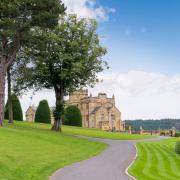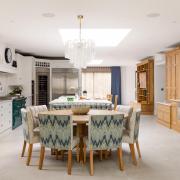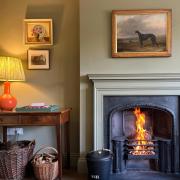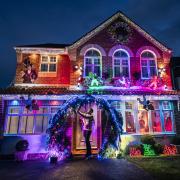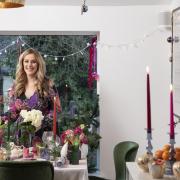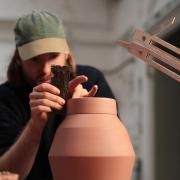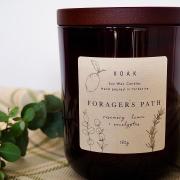Architectural secrets are uncovered by a couple as they take on the renovation of a farmhouse in West Yorkshire. Heather Dixon reports Photographs by Dave Burton
The warning in the sales brochure said it all: ‘Enter at your own risk’. And when Bridget and David Reed took their first tour of their Grade II listed former farmhouse near Huddersfield, they certainly took their life into their own hands. The floor in the entrance hall had caved into the cellar leaving a gaping hole; one of the walls was on the verge of collapse, there was a huge hole in the roof and the bathroom could only be reached by negotiating a precarious plank across a hole in the first floor.
It wasn’t exactly what Bridget had had in mind when they decided to move house, but David was delighted by the prospect of giving the dilapidated farmhouse a new lease of life.
What neither of them bargained for was the fact that the house was originally a 14th century medieval aisled hall, and that it contained its own stunning architectural secrets.
‘We thought it was tremendously exciting but terrifying,’ he said. ‘The scale of the task ahead didn’t bother us. Although we had never done anything on this scale before, we put our faith in the architect and builder - and they didn’t let us down.’
It wasn’t the first time Bridget and David, both retired, had considered buying the farmhouse. Fifteen years earlier they were invited by close friends to take it on as a joint project, creating two homes from the one property.
‘At the time we thought they must be mad. It had been empty for years and everything was overgrown,’ said Bridget. ‘We just didn’t have the vision.’
Their friends went on to self build while Bridget and David started looking for something a bit more conventional. ‘We found a bungalow we liked and were on the verge of buying it when we decided to have another look at the farmhouse, which was still for sale,’ said David. ‘asked the architect to view both and give us his opinion. He said there was no contest, that it was a ‘no brainer’ to renovate this one. Bridget and were terrified at the thought of it but he reassured us. He said both he and the builder had done much worse than this and there was nothing to worry about.’
he property was sold with planning permission to turn the adjoining18th century barn into a four-bedroom house, but Bridget and David agreed that they would rather stabilise the barn and use it themselves – initially for storage, but later as an extension of the house.
Everything seemed straight forward until the builder began to remove the crumbling wall plaster, floors and roof slates, leaving four bare walls and the rafters. It quickly became apparent that there was much more to the old stone building than they realised.
‘When the ceilings came down we discovered the long beam running through the middle of the house,’ said David. ‘We knew it was significant.
The builder thought it was around 300 years old but the architect contacted the conservation department who said the house was a former 14th century medieval aisled hall with a solar in the place now occupied by the barn.’ They also uncovered the beautiful timber frame which had been covered up over the years.
‘It was really exciting,’ said Bridget. ‘We had no idea that we had bought something so old and with so much history. We thought we would have a few pretty farmhouse beams and ended up with something quite amazing. The conservation officer was incredibly helpful. They could have listed the house on the spot, which would have been incredibly restrictive, but once they realised we weren’t going to damage the timbers they were happy to list the property while the work was going ahead.’
The discovery of the beautiful oak frame shaped the development of the build as the team worked hard to retain and restore as many of the original materials as possible. One of the main walls was so unsafe it had to be taken down stone-by-stone and rebuilt.
‘We used to come to the site every day to see how it was progressing,’ said David. We were initially told it would take three months but this kept extending, especially when rain almost brought work to a standstill in the summer because the roof was off and it was constantly wet inside.’
All the floorboards were replaced and a ladder was used to access the first floor until the main staircase was built. A smaller secret staircase towards the back of the house was removed, much to Bridget’s chagrin, to create more space in the sitting room, and partitions in the main hall which had once been used as a dairy, were removed to create one large open space.
‘We later discovered that they had been a very early example of this kind of partition, but there had to be a few compromises if we were to make it a practical family home,’ said David.
By the time Bridget and David sold their previous house most of the structural work had been done and they moved into the house, camping out in just one room, while they went ahead with a further three months of internal work were completed.
he couple made do with a microwave and a slow cooker for months until the kitchen was finally fitted – just in time for a family Christmas.‘It was a very basic Christmas,’ said Bridget. ‘We had no carpets and bare plaster on the walls, but after living in just one room for so long we were really excited to have so much space.’
he house is simply but effectively furnished with a mixture of antiques and modern fittings which complement the property. In 2007 they decided to add a breakfast/sun room to the side of the house to maximise the fabulous countryside views, choosing an oak frame to continue the theme of their home. Because the farmhouse was listed this was linked to it via a glass corridor.
Although the renovation took longer than anticipated and went over budget, Bridget and David are delighted with the results.
‘We went totally against general recommendation and put all our trust in the architect and the builder. They were absolutely fantastic to work with. When you hear about some of the horror stories we could easily have come unstuck, but the whole project was a wonderful adventure. I love the house. think you would have to take me out in a box.’
But Bridget isn’t so sure. ‘love this house but never say never,’ she said. ‘One day might like to move to somewhere modern and minimalistic – to try something totally different.’
Contacts
D&H Construction, builder (including roof, doors and windows) 01484 537826
R Marshall Associates, steel engineers, 01484 534051
Ian Stevenson, building consultant for farmhouse and barn, 01484 608900
Martin Wadsworth, electrician 01484 863214
Trevor Davison, joiner, 01484 604568
Andrew Locke, plumbing, 01484 860222
James Pinder Landscapes, 07831 348140 jamespinderlandscapes.co.uk
Atlas, bathroom fittings, 01484 886 312
G&R Spurr, French polishers of all oak beams, 01484 530785
Mallalieu Architects Ltd for garden room 01924 848334
Graham Booth, builder, 01484 606380/6
The print version of this article appeared in the November 2011 issue of Yorkshire Life
We can deliver a copy direct to your door – order online here



